Lifestyle
The Science Behind Food Cravings During Jet Lag
The science behind food cravings during jet lag reveals surprising hormonal shifts; discover how to navigate these challenges for a smoother journey.

Jet lag messes with your internal clock, leading to strong cravings for high-calorie comfort foods. As you cross time zones, your circadian rhythms get disrupted, which drives up hunger hormones like ghrelin and reduces satiety hormones like leptin. This hormonal imbalance, combined with stress and sleep deprivation, intensifies your desire for sugary and fatty snacks. Irregular meal times further complicate things, exacerbating cravings and affecting metabolism. By understanding how these factors interact, you can make better food choices on your journey. If you want insight into managing these cravings, there's plenty more to explore about this topic.
Key Takeaways
- Jet lag disrupts circadian rhythms, increasing appetite and cravings for high-calorie foods due to hormonal imbalances.
- Elevated ghrelin and decreased leptin levels during travel lead to stress-induced cravings for comfort foods.
- Sleep deprivation exacerbates hormonal changes, heightening the preference for unhealthy snacks and junk food.
- Irregular meal timing disrupts metabolism, reinforcing cravings for sugary and fatty foods.
- Aligning meal times with local time zones can help mitigate cravings and support overall health.
Understanding Jet Lag and Its Effects

Jet lag can leave you feeling disoriented and exhausted, thanks to the disruption of your body's internal biological clock. When you travel across multiple time zones, this clock struggles to adjust, leading to a cascade of symptoms. You might experience fatigue, cognitive impairments, and gastrointestinal disturbances.
These issues occur because your circadian rhythms, which help regulate sleep and various bodily functions, are thrown off balance. Additionally, cravings for specific foods can arise during this period, as certain dishes, like Muamba De Galinha, are often comforting options that evoke feelings of home and familiarity.
The severity of jet lag symptoms often increases with the number of time zones you cross, especially when traveling eastward. Your body clock typically operates on a cycle longer than 24 hours, making eastward travel particularly challenging. As a result, you may find yourself battling brain fog and a low mood, alongside digestive issues like diarrhea or constipation.
Recovering from jet lag usually takes about one day for each time zone crossed. To help reset your body clock, consider using strategies like light exposure and adjusting your meal times. These techniques can ease the adjustment and get your circadian rhythms back on track, improving your overall well-being during travel.
The Role of Circadian Rhythms
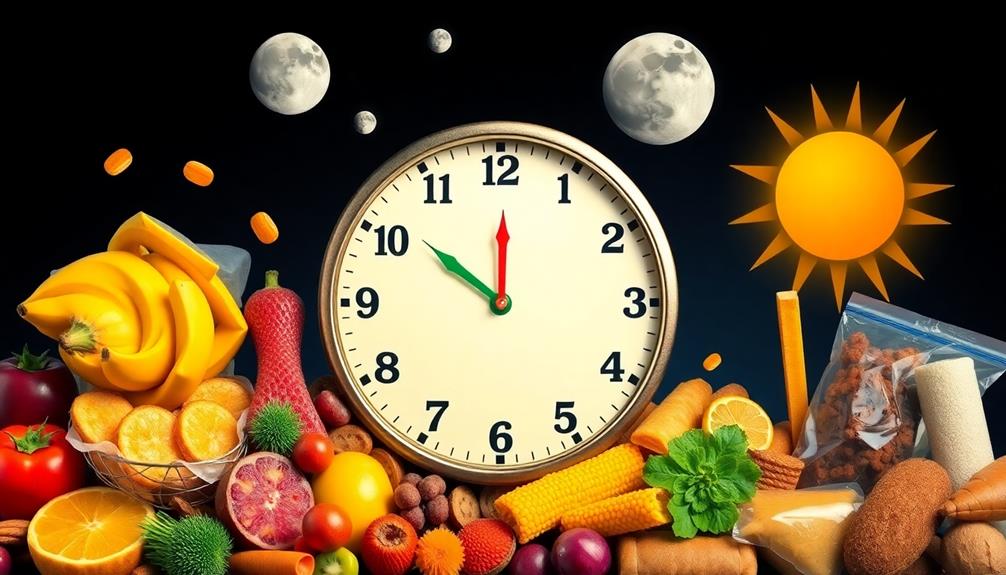
Circadian rhythms play a pivotal role in how your body responds to travel and food cravings during jet lag. These 24-hour cycles regulate essential physiological processes, including your sleep-wake patterns and metabolism.
When you cross time zones, disruptions in your circadian rhythms can lead to increased appetite and cravings for high-calorie foods, such as Red-Braised Pork Belly, as your body struggles to adapt. The suprachiasmatic nuclei (SCN) in your brain serve as the master clock that coordinates hormonal signals, like ghrelin, which regulates hunger.
When your internal clock is misaligned, you may experience stronger cravings. To combat this, aligning your meal timing with local time zones can help reset your body's internal clock and reduce jet lag-related cravings.
Eating patterns that clash with your circadian rhythms can exacerbate feelings of fatigue and cravings. As a result, it's essential to adjust your meal schedules during travel.
Hormonal Changes During Travel

When you travel across time zones, your hormone levels can get thrown out of balance, affecting how your body regulates appetite.
This can lead to a desire for comfort foods, such as a delicious Kue Putu, which are warm and sweet, making them particularly appealing during stressful travel.
Increased ghrelin and decreased leptin can lead to stress-induced cravings, making you reach for those high-calorie snacks.
This hormonal chaos, paired with disrupted circadian rhythms, complicates your ability to manage hunger and food choices effectively.
Hormones and Appetite Regulation
Traveling across time zones greatly disrupts your body's hormone balance, particularly those involved in appetite regulation. Hormonal changes during travel can lead to an increase in hunger, making it harder to resist cravings for unhealthy foods.
- Ghrelin levels rise in the evening, ramping up your appetite.
- Disrupted melatonin levels can confuse your hunger signals.
- Altered circadian rhythms impair insulin secretion, urging your body to crave carbohydrates.
- Sleep deprivation further exacerbates this cycle, leading to poor dietary choices.
As you navigate through jet lag, the balance between ghrelin and leptin becomes skewed. Ghrelin, the hormone that stimulates appetite, often spikes, while leptin, which tells your body when to stop eating, may not work effectively.
This imbalance can result in cravings for high-calorie foods, particularly when you're feeling fatigued. Disrupted melatonin levels can also confuse your internal clock, affecting when you feel hungry.
All these factors contribute to a perfect storm of cravings, making it essential to be mindful of what you eat during your travels to maintain a healthy diet and avoid unwanted weight gain.
Stress-Induced Cravings
Jet lag can considerably increase stress levels, triggering hormonal changes that lead to intense cravings for high-calorie comfort foods. When you travel, elevated cortisol levels can intensify these stress-induced cravings, causing you to seek out sugary and fatty foods. Sleep deprivation exacerbates this issue, as it raises levels of ghrelin, the hunger hormone, making it harder to resist those tempting treats.
Here's a quick breakdown of how hormonal changes influence your food choices during jet lag:
| Hormone | Effect on Appetite | Response |
|---|---|---|
| Cortisol | Increases cravings | Desire for comfort food |
| Ghrelin | Signals hunger | Craving for sweets |
| Leptin | Reduces satiety signals | Increased appetite |
Understanding these hormonal fluctuations can help you make better choices when those stress-induced cravings hit. By being aware of how jet lag affects your body, you can focus on healthier snacks and manage cravings more effectively. Stay mindful, and you'll find it easier to navigate your travel-related appetite challenges.
Circadian Rhythm Disruption
Circadian rhythm disruption during your travels can wreak havoc on your body's hormonal balance, leading to heightened cravings for unhealthy foods.
When your internal clock is out of sync, hormones like ghrelin and leptin get thrown off, making you more likely to crave high-calorie snacks.
Here's what happens when your circadian rhythm is disrupted:
- You experience increased ghrelin levels in the evening, which drives cravings for unhealthy foods.
- Hormonal imbalances can impair insulin sensitivity and glucose metabolism, pushing you toward sugary options.
- Sleep deprivation, common with jet lag, exacerbates these hormonal shifts and can lead to overeating the next day.
- A consistent meal timing strategy can help stabilize these hormonal changes, aligning your body with local time zones.
To combat these cravings during your travels, focus on maintaining a regular eating schedule as best as you can.
Impact of Sleep Deprivation
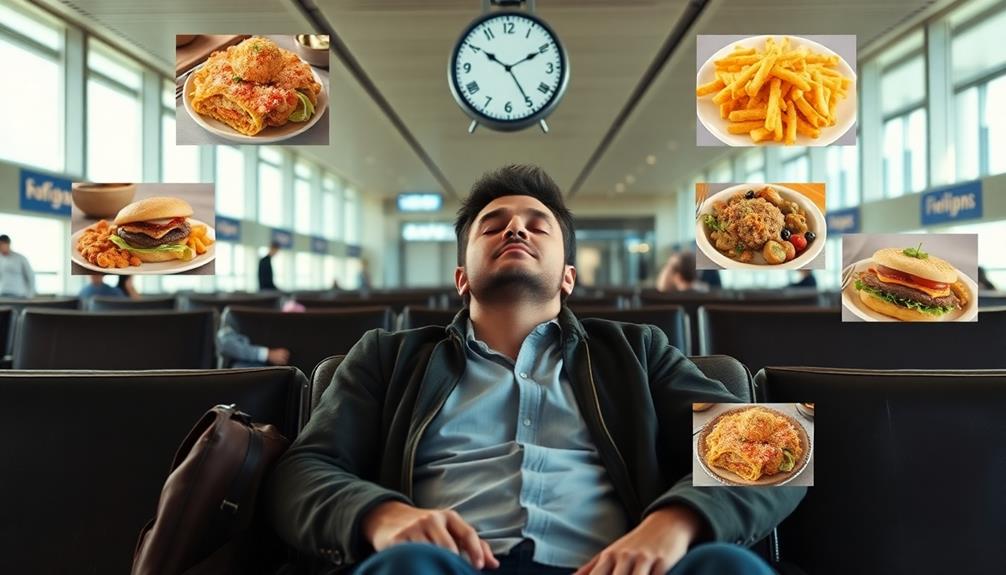
Sleep deprivation can have a profound impact on your food choices and cravings. When you're running low on sleep, your body craves high-calorie, unhealthy foods. This isn't just a coincidence; your eating habits suffer as your body's hunger hormones, like ghrelin, go haywire. Research shows that even one extra hour of sleep can help improve these habits.
| Effects of Sleep Deprivation | Impact on Eating Habits | Emotional Response |
|---|---|---|
| Increased cravings for junk food | Preference for unhealthy snacks | Guilt and frustration |
| Elevated ghrelin levels | Higher calorie consumption | Stress and anxiety |
| Delayed meal times | Skipping meals or overeating later | Physical discomfort |
| Disrupted metabolism | Risk of obesity | Fear of weight gain |
| Social jet lag effects | Irregular eating patterns | Confusion and helplessness |
When you're experiencing social jet lag and sleep deprivation, it's easy to fall into a pattern of late-night snacking and binge eating. This can lead to a cycle that's tough to break, impacting both your physical health and emotional well-being. Prioritizing sleep could be the key to better food choices and a healthier you.
Eating Patterns and Cravings
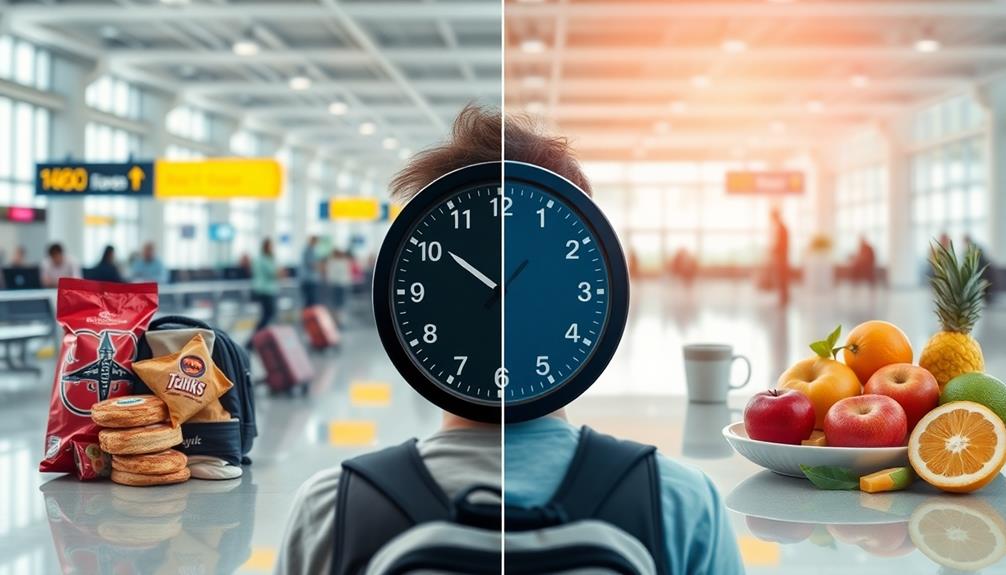
When you're jet lagged, your circadian rhythm gets thrown off, and that can mess with your eating patterns.
You might find yourself craving high-calorie foods at odd times, especially if your meal schedule doesn't align with the local time.
Understanding how meal timing affects your cravings can help you make better dietary choices while traveling.
Circadian Rhythm Disruption
Often, disruptions in your body's internal clock during jet lag can throw your eating patterns out of sync, leading to unexpected cravings for high-calorie and unhealthy snacks.
This misalignment is primarily due to the impact on your circadian clock, which regulates meal timing and appetite. When your meal timing becomes inconsistent, you may find yourself reaching for energy-dense foods, especially in the evening when ghrelin levels rise.
To better understand this phenomenon, consider these key points:
- Irregular meal timing can impair insulin secretion and glucose tolerance.
- Cravings for unhealthy snacks can increase, particularly when combined with social jet lag.
- Maintaining consistent meal timing helps regulate your appetite.
- Aligning your meals with local time zones can improve nutrient utilization.
Meal Timing Variability
Meal timing variability greatly impacts your eating patterns and cravings, especially during periods of jet lag. When your meal times fluctuate, it disrupts your circadian rhythms, which regulate hunger and appetite. This disruption can lead to an increase in ghrelin levels, particularly in the evening, heightening your desire for high-calorie foods. Additionally, studies show that delaying meals can associate with a higher Body Mass Index (BMI), emphasizing the risks tied to inconsistent eating patterns.
Here's a quick overview of meal timing variability and its effects:
| Factor | Impact | Recommendation |
|---|---|---|
| Meal Timing Variability | Disrupted eating patterns | Maintain consistent meal times |
| Circadian Rhythms | Regulates hunger and appetite | Align meals with natural body clock |
| Body Temperature | Influences metabolic processes | Eat at regular intervals to stabilize |
| Ghrelin Levels | Increased cravings for high-calorie foods | Control meal timing to manage appetite |
| Social Jet Lag | Poor dietary habits and delayed first meals | Prioritize early and regular meals |
High-Calorie Food Preferences
As you navigate the challenges of jet lag, you may find yourself gravitating toward high-calorie foods, a tendency driven by disrupted circadian rhythms and altered hunger hormones. Your body's sleep deprivation can lead to increased cravings for energy-dense options, making it all too easy to reach for unhealthy snacks.
Here are some reasons why you might prefer high-calorie foods during this time:
- Altered hunger hormones: Ghrelin levels may spike, increasing your appetite for sugary and fatty foods.
- Sleep deprivation: Lack of rest can correlate with higher calorie consumption the following day.
- Inconsistent meal timing: This variability disrupts your metabolism, reinforcing cravings for quick energy sources.
- Increased cravings: The body's need for energy can push you towards unhealthy choices when traveling.
In essence, the combination of your body's physiological responses and environmental factors during jet lag heightens your preference for high-calorie foods.
Understanding this connection can help you make more mindful choices, steering your cravings toward healthier options even when your circadian rhythms are out of sync.
The Gut-Brain Connection

The gut-brain connection greatly influences your food cravings and appetite. Your gut bacteria play a vital role in producing neurotransmitters that send signals to your brain, impacting both your mood and hunger levels.
When you experience jet lag, disruptions in your circadian rhythms can lead to an imbalance in gut microbiota, heightening cravings for unhealthy, calorie-rich foods. This is particularly true if you're dealing with social jet lag, where elevated levels of ghrelin, the hormone that stimulates appetite, can push you towards calorie-dense meals.
Poor gut health, often characterized by a lack of diversity in gut bacteria, can amplify these cravings and lead to unhealthy eating behaviors, especially during travel.
It's important to be mindful of your diet during these times. Research shows that maintaining consistent meal timing and focusing on improving gut health through a balanced diet can help manage cravings.
Strategies to Manage Cravings
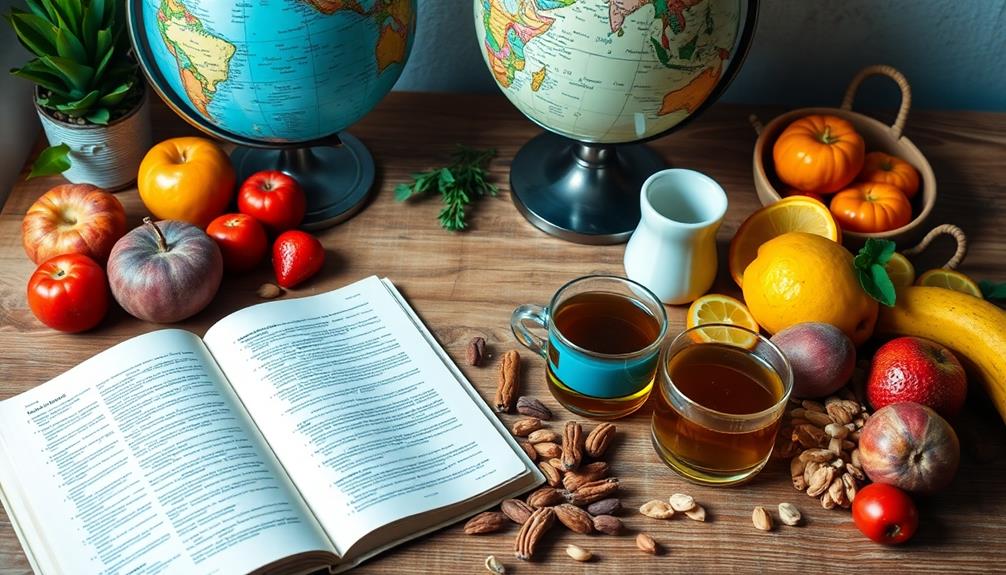
Jet lag can throw your body out of sync, leading to intense food cravings that can derail your healthy eating habits.
To manage these cravings effectively, consider the following strategies:
- Maintain regular meal timing: Align your meals with your destination's time zone to help reset your internal body clock.
- Stay hydrated: Drink plenty of water, as dehydration can often be mistaken for hunger, prompting unnecessary snacking.
- Incorporate physical activity: Engage in light exercises like walking or stretching to boost your mood and release endorphins, which can help curb cravings.
- Practice mindful eating: Pay attention to your hunger cues and savor each bite, allowing yourself to make healthier food choices, even when jet lagged.
Meal Timing and Nutritional Choices

Managing meal timing during travel is essential for overcoming the effects of jet lag and maintaining healthy nutritional choices. When your internal clock is disrupted, you may find yourself craving high-calorie foods. Research shows that people experiencing social jet lag tend to consume more unhealthy options like sugar-sweetened beverages and processed snacks due to irregular eating patterns.
To combat this, consider aligning your meal timing with the local time zone as soon as you arrive at your destination. Delayed meals, such as postponing breakfast by an average of two hours on weekends, can negatively affect your diet quality and contribute to unfavorable weight outcomes.
You need to establish a structured meal plan that fosters consistent eating habits to mitigate the effects of jet lag. Eating jet lag, the difference in meal timing between weekdays and weekends, is linked to a higher Body Mass Index (BMI).
Long-Term Health Implications

Irregular meal timing and unhealthy food choices during travel can have lasting impacts on your health. When you experience jet lag, your circadian system gets disrupted, leading to food cravings that often result in poor dietary choices. This behavior can contribute to increased calorie consumption, weight gain, and obesity.
Over time, these patterns can severely affect your metabolic health, raising the risk for chronic conditions like diabetes and cardiovascular diseases.
Consider the following long-term implications:
- Altered gut microbiome can lead to inflammation and nutrient absorption issues.
- Increased likelihood of unfavorable eating patterns and poor food choices.
- Heightened food cravings driven by psychological effects, influencing mental health.
- Greater risk of developing chronic diseases due to poor insulin sensitivity and glucose tolerance.
Frequently Asked Questions
Why Does Jet Lag Make Me Hungry?
Jet lag makes you hungry because it disrupts your body's internal clock, throwing off hunger signals. You're likely to crave high-calorie foods, especially when sleep-deprived, leading to unusual eating patterns and increased appetite.
Does Eating Help With Jet Lag?
Imagine your body as a clock, ticking out of sync. Eating at new times helps reset that clock, easing jet lag's grip. So, when you land, enjoy meals aligned with the local schedule for smoother adjustment.
What Is the Science Behind Jetlag?
Jet lag's caused by your body's internal clock being out of sync with the new time zone. This misalignment leads to fatigue and mood changes, making it tough to adjust after long travels.
Does Jet Lag Affect Digestion?
Yes, jet lag definitely affects digestion. You might experience gastrointestinal issues like bloating or constipation due to your body's internal clock being out of sync, making it harder for your system to process food efficiently.
Conclusion
In maneuvering the choppy waters of jet lag, you're not just battling fatigue; you're also grappling with those insistent cravings that echo like sirens calling you to indulgence. By understanding the science behind these urges, you can steer your ship towards healthier choices. Embrace strategies that align with your body's rhythms, and you'll find calmer seas ahead. Remember, a well-timed meal can be your compass in this travel adventure, guiding you back to balance and well-being.
Lifestyle
How Cultural Diaspora Shapes Fusion Cuisine Trends
Savor the intriguing ways cultural diaspora influences fusion cuisine trends, as new flavors emerge and redefine our culinary landscape—discover what’s next!
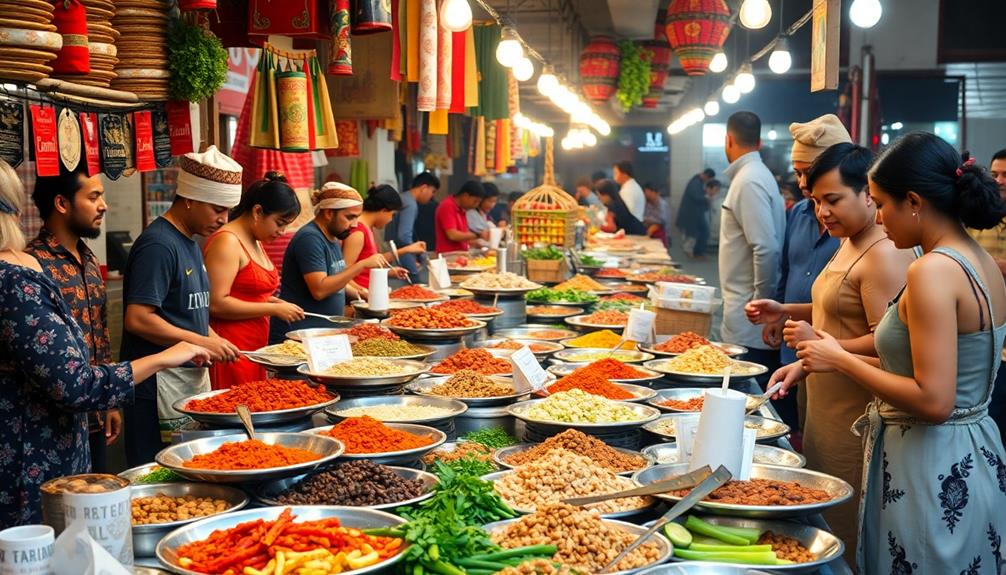
Cultural diaspora shapes fusion cuisine by blending diverse culinary techniques and ingredients, creating unique dining experiences. As people migrate, they bring their flavors, enriching local cuisines with new tastes. You might notice dishes like Korean tacos or sushi burritos that reflect this vibrant interplay of cultures. Chefs often experiment with combining traditional recipes and contemporary techniques, appealing to adventurous diners craving innovative flavors. Plus, the rise of food trucks and pop-up restaurants encourages this culinary creativity. If you're curious about how these trends continue to evolve, you'll find even more exciting insights about the future of fusion cuisine.
Key Takeaways
- Cultural diaspora facilitates the introduction of diverse culinary techniques and ingredients, enriching local cuisines through cross-cultural exchanges.
- Immigrants adapt traditional recipes, leading to innovative dishes that reflect blended culinary traditions and local tastes.
- Ethnic restaurants serve as cultural ambassadors, promoting heritage and fostering appreciation for global flavors within host countries.
- Globalization enhances accessibility to international ingredients, encouraging experimentation and creativity in fusion cuisine.
- Sustainability trends drive the use of local ingredients and responsible cooking practices, reflecting environmental awareness in culinary innovations.
Cultural Diffusion Explained
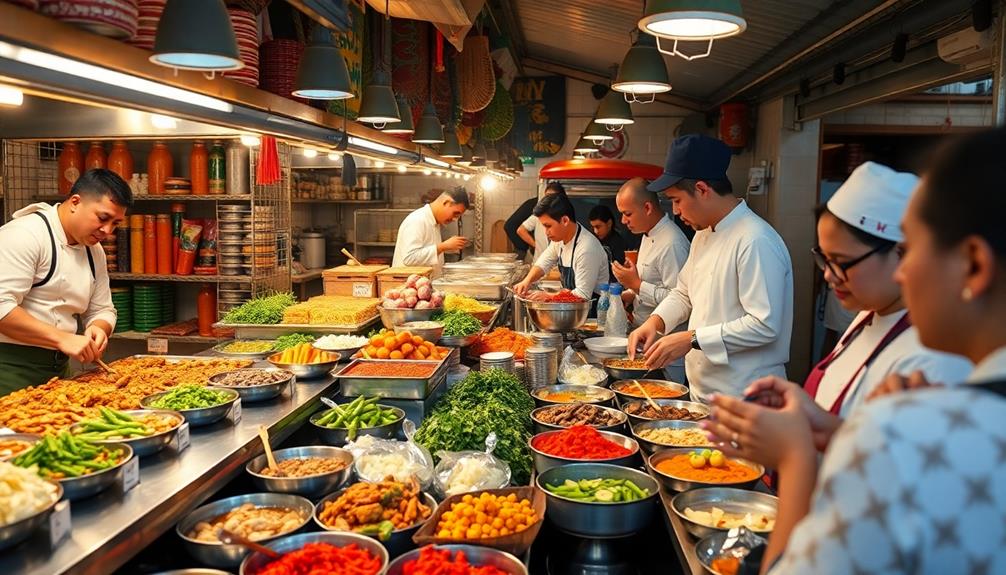
Cultural diffusion plays an essential role in shaping the culinary landscape we enjoy today. This process involves the spread of cultural beliefs and practices, primarily through trade, migration, and conquest, which influences global cuisine.
You might notice how fusion cuisine blends culinary traditions, creating innovative dishes that highlight flavors from different cultures. For instance, Indo-Chinese and Tex-Mex are perfect examples of how diverse culinary practices can merge. Brazilian cuisine also exemplifies this blend, showcasing regional variations that reflect the country's rich cultural tapestry.
Consider the historical spice trade, where spices from India transformed European culinary practices, broadening their flavor profiles. This cultural exchange didn't just stop there; today, you can find creative dishes like the sushi burrito, combining traditional recipes with local ingredients.
This ongoing cultural diffusion continues to shape food culture, allowing you to explore new cooking techniques and diverse flavors.
Fusion Cuisine Evolution
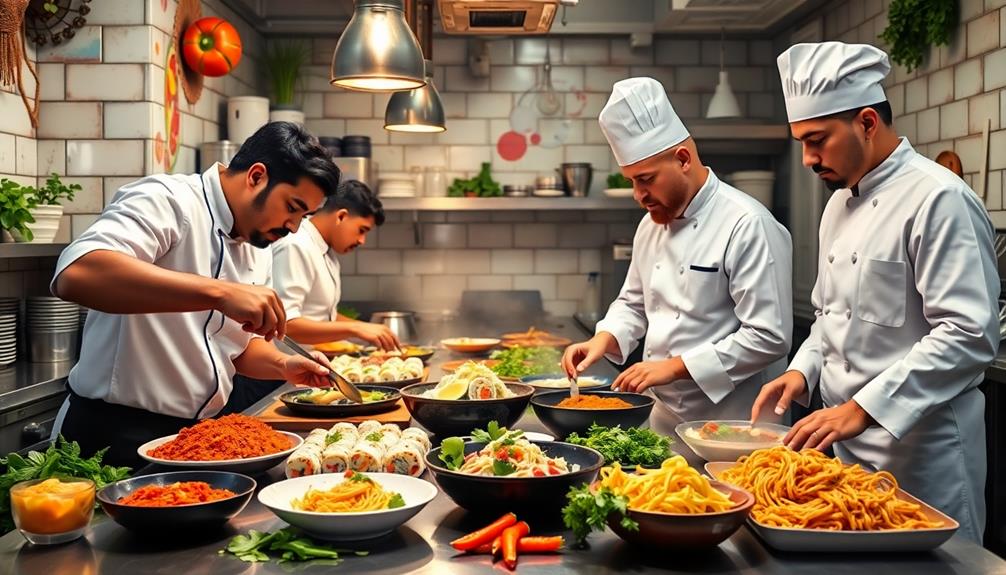
The evolution of fusion cuisine reflects the dynamic interplay of cultures in the culinary world. Since the 1980s, chefs like Wolfgang Puck and Roy Yamaguchi have blended culinary traditions, giving rise to terms like Pan-Asian and Cal-Asian. This cultural diffusion has allowed innovative dishes such as Korean tacos and Japanese-Peruvian ceviche to emerge, showcasing diverse flavor profiles shaped by immigrant populations.
As globalization continues to intertwine food cultures, culinary creativity flourishes. Younger diners are particularly drawn to fusion cuisine, seeking unique dining experiences that challenge conventional boundaries. Food trucks and casual dining spots are at the forefront of this movement, experimenting with daring combinations that reflect a more accepting attitude toward culinary innovation.
Here's a quick look at the key elements driving the evolution of fusion cuisine:
| Aspect | Description |
|---|---|
| Cultural Influences | Blending of diverse culinary traditions |
| Innovative Dishes | Creation of new, hybrid dishes |
| Immigrant Populations | Impact of diverse communities on culinary trends |
| Globalization | Increased accessibility to global ingredients |
| Dining Experiences | Adventurous and unique dining options |
As fusion cuisine evolves, it promises to remain a crucial part of our culinary landscape.
Influences of Migration
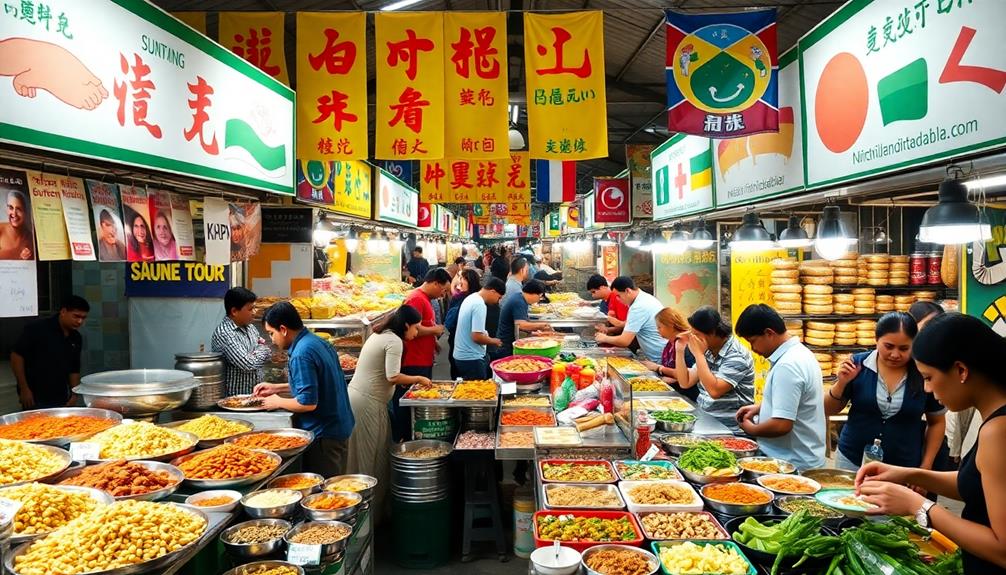
Migration reshapes culinary landscapes by introducing new ingredients and cooking methods to host countries. For instance, traditional Indonesian desserts like Kue Putu and Dadar Gulung reflect the rich flavors that immigrant communities bring to their new homes.
As communities blend, you'll see how culinary traditions evolve, giving rise to exciting fusion cuisine. This transformation often leads to innovative dishes that reflect a mix of cultural heritage.
Here are three key influences of migration on food trends:
- Diverse Ingredients: Immigrants bring local ingredients from their home countries, enriching the culinary scene and inspiring chefs to experiment with flavors.
- Culinary Mashups: Unique combinations like Korean-Mexican tacos or Japanese-Peruvian ceviche showcase how cultural interactions inspire creativity in cooking.
- Ethnic Restaurants as Cultural Ambassadors: These establishments not only serve traditional dishes but also adapt recipes to local tastes, creating a bridge between communities.
Through migration, culinary practices expand, allowing you to savor dishes that celebrate both heritage and innovation.
As you explore these fusion cuisines, you'll discover how migrant communities shape food trends, bringing new life to local dining experiences. The result is a vibrant tapestry of flavors, reflecting the dynamic nature of our ever-evolving global food landscape.
Indian Diaspora Contributions
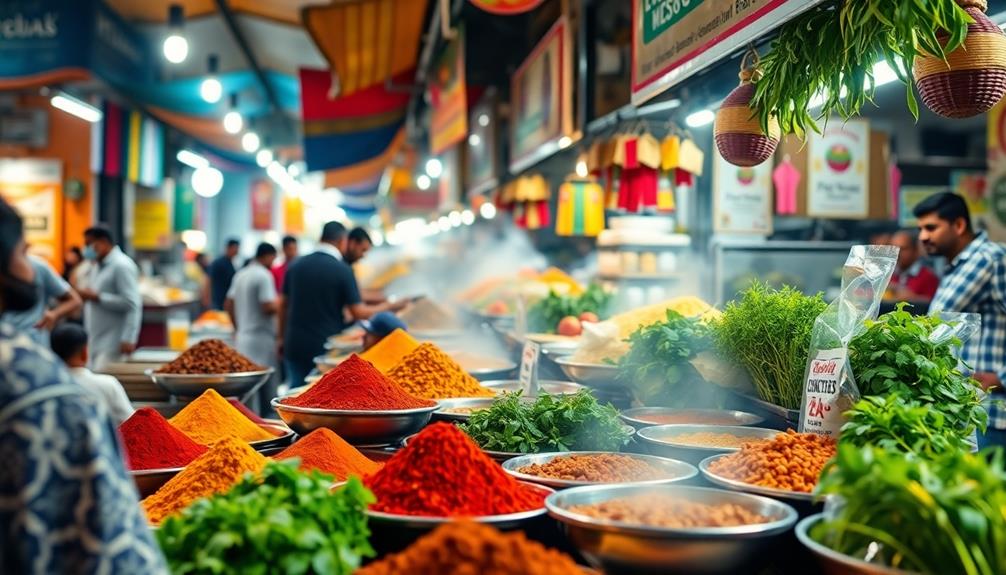
From the bustling streets of London to the vibrant markets of Dubai, the Indian diaspora has made a remarkable impact on global cuisine. By introducing traditional Indian flavors and culinary traditions, it's enriched local cuisines in various countries.
For instance, dishes like Mushroom Masala showcase how earthy flavors can be enhanced through spices, making them appealing to diverse palates. Indian expatriate chefs have led this evolution through cultural exchange, adapting traditional recipes with local ingredients to create innovative dishes like Indian-inspired sushi and curry pasta.
Indian restaurants worldwide act as cultural ambassadors, showcasing the richness of Indian culinary heritage and contributing to local economies. These establishments often feature diverse menus that blend traditional and contemporary Indian dishes, reflecting the global food movement's dynamics.
Events and festivals celebrating Indian cuisine in cities like Dubai further highlight the contributions of the Indian community, bringing together Indian flavors and local culinary practices.
Moreover, the emphasis on vegetarianism within Indian cuisine is gaining traction globally. Chefs are innovating plant-based dishes that honor traditional practices while appealing to contemporary dining trends.
This focus on sustainability not only attracts food enthusiasts but also solidifies the Indian diaspora's role in shaping fusion cuisine across the globe.
Culinary Mash-Ups Today
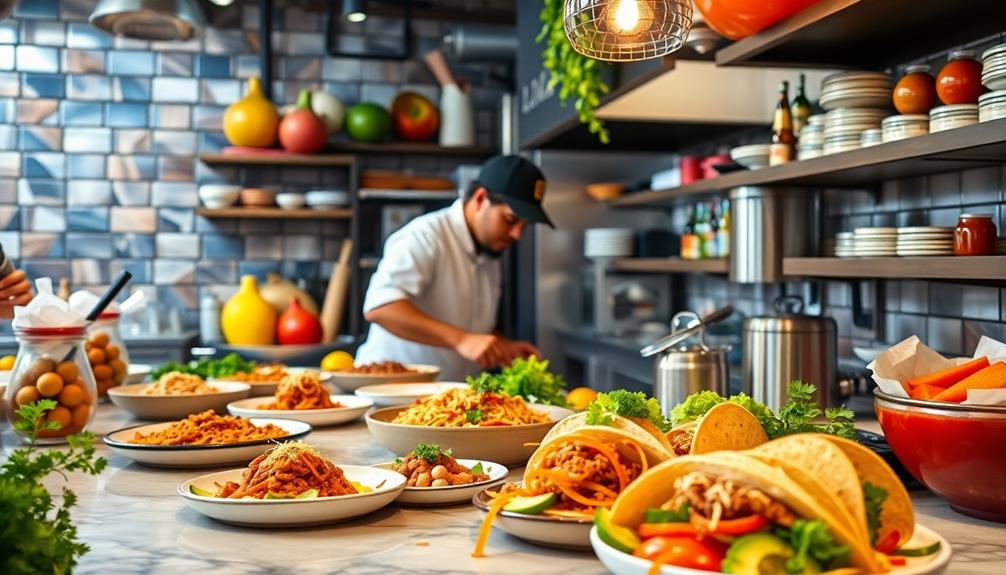
Culinary mash-ups today reflect a broader trend of blending diverse food cultures, taking inspiration from innovations like the Cronut® and ramen burgers.
These creative combinations push the boundaries of traditional cooking styles, offering bold flavors that resonate with adventurous eaters. Food trucks and Quick Service Restaurants (QSRs) are at the forefront, crafting innovative dishes that highlight local ingredients and the cultural significance of various cuisines.
Here are three notable examples of today's culinary mash-ups:
- Korean Tacos: A fusion of Korean BBQ and traditional Mexican tacos, showcasing a blend of spices and textures.
- Sushi Burritos: Wrapping sushi ingredients in a burrito format, this dish combines the best of both worlds, attracting fans of diverse culinary traditions.
- Waffle Tacos: An inventive take on breakfast, merging waffles and tacos for a sweet-savory delight.
Despite concerns about the focus on novelty over quality, these culinary creations continue to thrive, reflecting a sustained consumer interest in fusion food that celebrates a community or region's rich culinary heritage.
Future Trends in Fusion Cuisine
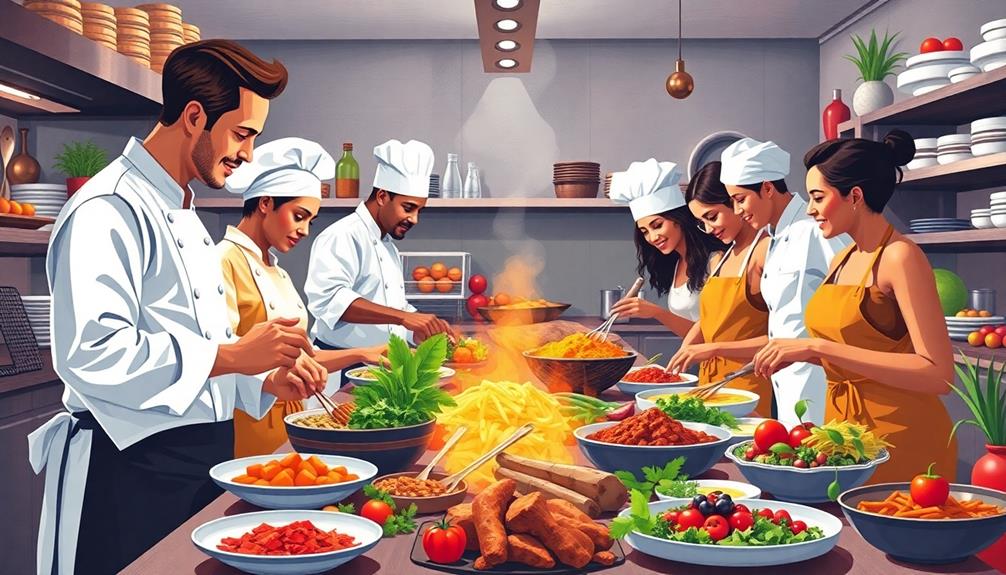
The future of fusion cuisine is bright, driven by a dynamic interplay of globalization and cultural exchange. As migration continues to shape culinary landscapes, you can expect chefs to create innovative fusion dishes that blend traditional culinary techniques with local ingredients.
This evolution caters to diverse palates and embraces the rise of third-culture cuisine, where dining experiences celebrate various culinary heritages.
You'll notice adventurous flavors gaining traction, with dishes like Korean-Mexican tacos and Japanese-Peruvian ceviche becoming mainstream favorites, especially among younger audiences.
Social media and food influencers play an essential role in promoting these trends, as restaurants use technology to create buzz and engage customers in unique dining experiences.
Sustainability will also shape the future of fusion cuisine, as chefs increasingly advocate for environmentally responsible cooking practices.
They'll focus on sourcing local ingredients while exploring global flavors, ensuring that their fusion dishes not only tantalize taste buds but also respect the planet.
As these trends unfold, expect a vibrant culinary landscape that reflects the rich tapestry of our interconnected world, inviting you to explore and indulge in a diverse array of flavors and experiences.
Frequently Asked Questions
What Are the Cultural Roots to Fusion Cuisine?
Fusion cuisine's cultural roots lie in centuries of trade and migration. You'll find diverse culinary practices blending together, creating innovative dishes as immigrant populations introduce their traditional flavors, reflecting a rich tapestry of shared culinary heritage.
Why Has Fusion Cuisine Become so Popular?
Fusion cuisine's like a vibrant tapestry, weaving together flavors from around the world. You've embraced this culinary trend due to globalization, adventurous palates, and social media showcasing unique dishes that tantalize and excite your taste buds.
What Is Cultural Fusion in the Field of Food?
Cultural fusion in food means blending culinary traditions from different backgrounds, creating innovative dishes that highlight unique flavors. You'll often find exciting combinations that surprise your palate, reflecting both creativity and multicultural influences in dining.
How Does Culture Influence Food?
Culture influences food by shaping your tastes, cooking methods, and ingredient choices. When you embrace new traditions, you create unique dishes that reflect your experiences, enhancing your culinary journey and connecting you to diverse communities.
Conclusion
As you explore the vibrant world of fusion cuisine, you'll see how cultural diaspora weaves together flavors like a tapestry of stories. Just as spices traveled the Silk Road, today's culinary mash-ups reflect journeys of migration and innovation. Embrace the delicious possibilities ahead, where each bite is a celebration of diversity and creativity. The future of fusion cuisine isn't just on your plate; it's a shared experience that transcends borders and unites us all.
Lifestyle
The Impact of Food Packaging Transparency on Consumer Trust
Just how much does food packaging transparency influence your trust and purchasing decisions? Discover the surprising effects that could change your shopping habits.

Transparent food packaging greatly impacts your trust in the products you buy. It allows you to see the quality and freshness at a glance, enhancing your perception of safety and overall value. Consumers like you are more likely to choose organic options and support brands that prioritize environmental sustainability. Research shows that transparent packaging not only increases your purchase intentions but also fosters a deeper loyalty to brands. With clear visuals, you feel more empowered to make informed choices about your food. There's more to uncover about how transparency shapes consumer behavior and trust, so stick around to learn further insights.
Key Takeaways
- Transparent packaging enhances consumer trust by allowing direct inspection of food quality and ingredients.
- Visual clarity boosts perceptions of product quality, particularly for organic foods.
- Consumers exhibit higher purchase intentions when they can visually assess freshness and safety.
- Aesthetic appeal in transparent packaging correlates with increased brand loyalty and satisfaction.
- Eco-conscious consumers favor brands with transparent packaging, aligning with their values of sustainability and ethical sourcing.
Importance of Transparent Packaging
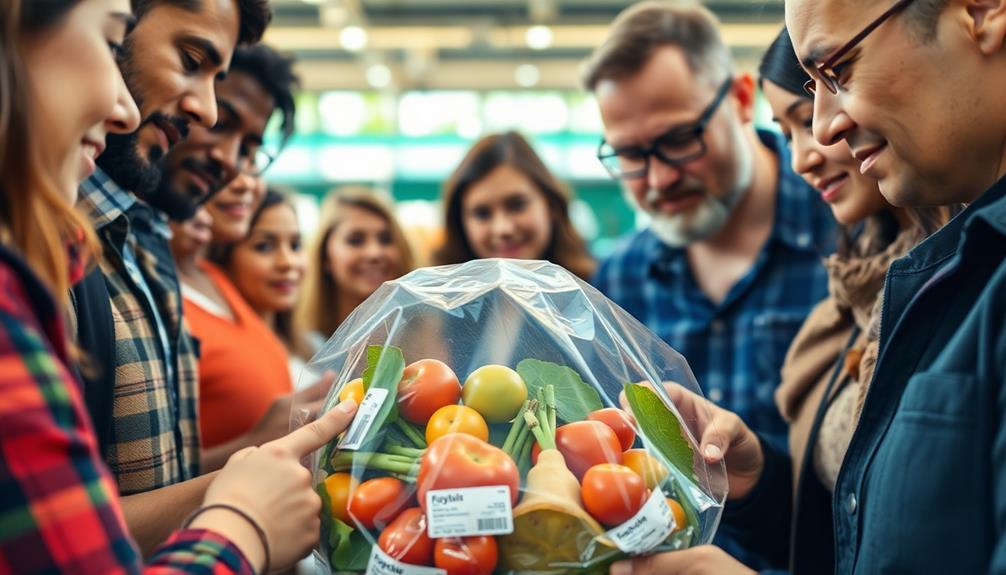
Transparent packaging plays an essential role in enhancing consumer trust and engagement with food products. When you can see what you're buying, it boosts your perception of product quality. This visual clarity allows you to assess food safety and quality easily, making it more likely that you'll choose organic food options. For instance, with Nettle and Potato Soup, the vibrant colors and fresh ingredients showcased in transparent packaging can highlight the dish's nutritional benefits.
The appeal of transparent packaging directly influences your purchase intentions, especially as you seek reliable, high-quality products.
Moreover, transparent packaging aligns with your preferences for environmental sustainability. Studies show that when you can see the product, you're more likely to feel connected to eco-friendly practices. This connection heightens your green purchasing intentions, particularly as you become increasingly aware of ecological concerns.
Clear labeling language on transparent packages reinforces your trust in the product, as it provides you with the information you need to make informed decisions.
The aesthetic appeal of transparent packaging not only satisfies your desire for visual engagement but also enhances the marketability of organic products. Ultimately, transparent packaging meets your expectations and fosters a stronger bond between you and the food you choose, driving your commitment to quality and sustainability.
Research Methodology and Findings

The impact of transparent packaging on consumer behavior has been the focus of recent research, revealing valuable insights about its effectiveness. A study involving 119 UK participants aged 18 to 58 assessed how transparent packaging influenced product evaluations across four categories, including food items like Red-Braised Pork Belly and snacks.
The findings showed that transparent packaging notably boosted purchase intentions, enhancing perceived freshness and food quality and safety. You'd likely feel a greater willingness to pay for products in transparent packages compared to opaque ones.
The empirical research demonstrated that transparency in packaging positively influenced consumer trust by increasing the perceived attractiveness and tastiness of the products. Additionally, the study accounted for aesthetic considerations, showing that visually appealing transparent packaging correlated with higher purchase intentions and overall consumer satisfaction.
Despite a minor data loss affecting a few participants, the study design proved reliable, yielding robust results across various product categories like pasta, chocolates, salmon, and granola.
These insights emphasize the critical role of transparent packaging in shaping purchasing decisions, making it an essential consideration for brands aiming to enhance consumer trust and engagement.
Effects on Consumer Behavior

When you see a product in transparent packaging, you're more likely to assess its quality visually, which can influence your buying decision.
This transparency builds trust, especially when it comes to organic foods, making you feel more confident about what you're purchasing.
Additionally, the emphasis on fresh ingredients, similar to how Brazilian cuisine showcases local produce like cassava and seafood, can further enhance this perception of quality.
Plus, if you're eco-conscious, knowing the brand cares about clear packaging can sway your choice toward greener options.
Visual Quality Assessment
Seeing food through transparent packaging can greatly influence your perception of quality and safety. When you can visually assess food quality and ingredients, it reinforces your consumer trust and increases the likelihood of choosing organic options perceived as fresher and safer.
Research shows that products in transparent packaging are often seen as more attractive and of higher quality, which makes you more willing to pay compared to those in opaque packages.
The appealing visuals in transparent packaging don't just look good; they evoke sensory responses that heighten your taste expectations and cravings. This connection to what you can see plays a significant role in your purchase decision-making.
You're likely to feel a stronger bond with products when you can monitor their freshness, enhancing your perceived food safety.
Aesthetic considerations matter too; attractive visuals in transparent packages correlate with increased purchase intentions across various product categories.
Trust Through Transparency
Transparent packaging not only enhances visual appeal but also builds consumer trust by allowing you to inspect the food's quality and ingredients directly. When you can see what you're buying, you're likely to feel more confident about its freshness and overall quality. This visual inspection reinforces your perception of the product, especially with organic food items, which often come with heightened expectations.
Research shows that transparent packaging greatly boosts your purchase intentions. You appreciate knowing the nutritional information and product attributes upfront, which helps you make informed decisions. This transparency also fosters brand loyalty, as you're more inclined to trust brands that openly communicate their offerings.
Moreover, transparent packaging isn't just about aesthetics; it aligns with your ecological concerns. Studies indicate that when you're faced with transparent packaging, you're more likely to reflect on the ecological impact of your purchase.
Consequently, the connection between transparent packaging and consumer trust becomes clear. By choosing products that showcase their quality and integrity, you're not only satisfying your immediate needs but also supporting brands that prioritize transparency and responsibility.
Eco-conscious Buying Decisions
With a growing emphasis on sustainability, eco-conscious buying decisions have become pivotal in shaping consumer behavior.
You're likely to notice how transparent packaging enhances your trust in products, especially when it comes to organic foods. This clarity allows you to assess food quality and ingredients, reinforcing your confidence in sustainability claims.
Here are three key factors influencing your eco-conscious buying choices:
- Informed Decision-Making: Transparent packaging communicates product attributes clearly, making it easier for you to choose eco-friendly options.
- Environmental Consciousness: When you see transparent packaging, it raises your awareness about the environmental impact of your purchasing choices, aligning with your values.
- Consumer Trust: As you engage with brands that value transparency, your trust in them grows, prompting you to support their sustainable initiatives.
Tourists and consumers alike are increasingly favoring products that showcase their commitment to sustainability.
This shift highlights how transparent packaging not only meets consumer expectations but also fosters lasting eco-conscious buying habits, ultimately benefiting both you and the planet.
Factors Influencing Purchase Decisions

When consumers can see the quality and ingredients of a product clearly, their trust in the brand increases substantially. Transparent packaging plays a vital role in shaping your purchase decisions. When you can easily assess freshness and safety, your confidence in the product heightens.
Research shows that when products are presented in transparent packaging, you're more likely to lean toward eco-conscious choices, particularly regarding organic food.
The aesthetic appeal of transparent packaging can't be overlooked. You likely find it more visually pleasing than opaque alternatives, which can influence your perception of product quality.
The visual cues offered by clear packaging—like vibrant colors and textures—effectively communicate attributes that enhance your expectations for taste and quality.
Additionally, your ecological concerns and connection to nature are positively impacted by transparent packaging, which can drive your intent to purchase sustainable products.
By choosing brands that prioritize transparency, you not only support your own values but also foster a market that prioritizes sustainability and quality.
Ultimately, the clarity offered by transparent packaging builds consumer trust and shapes your purchase decisions in significant ways.
Visual Appeal and Trust

The visual appeal of packaging greatly shapes your trust in a product. When you see transparent packaging, it not only allows you to assess food quality but also enhances your perception of freshness and safety.
Here are three significant ways visual appeal impacts your consumer trust:
- Aesthetic Appeal: Attractive packaging design captures your attention, making the product more desirable. Transparent materials often convey a sense of honesty, boosting your willingness to pay more.
- Enhanced Purchase Intentions: When you can see the product inside, it reinforces your belief in its authenticity. This transparency often translates into higher purchase intentions, especially for organic foods.
- Stronger Sensory Responses: The visual clarity of transparent packaging can trigger feelings of hunger or cravings, positively influencing your consumer evaluations. You're likely to associate visible quality with better taste and freshness.
Ultimately, transparent packaging plays an essential role in shaping your trust in food products. If the contents match your expectations, your confidence in the brand strengthens, leading to loyalty and repeat purchases.
Implications for Retail Strategies
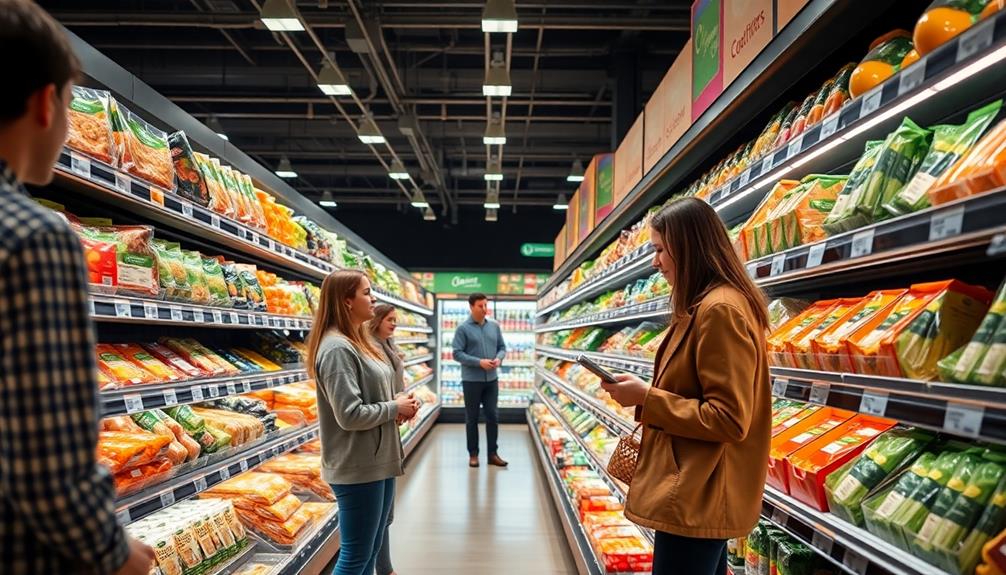
Retail strategies need to adapt to the growing consumer preference for transparent packaging, as studies show that 65% of shoppers are more likely to choose products that allow them to see what's inside.
By embracing transparent packaging, you can greatly enhance consumer trust and boost purchase intentions, particularly for organic and sustainably sourced products. Customers today aren't only concerned about food quality but also about product origins and ethical practices.
Incorporating transparent packaging into your retail strategies aligns with this ecological concern, appealing to those who value sustainability.
The visual clarity of these packages allows consumers to assess freshness and quality directly, reinforcing their trust in your brand.
Furthermore, aesthetically pleasing transparent packaging is more engaging than opaque alternatives, improving the marketability of your products in crowded retail spaces.
By providing clear insights into what's inside, you foster a connection with shoppers that encourages loyalty and repeat purchases.
Ultimately, adapting your retail strategies to include transparent packaging can set you apart in a competitive market, catering to the evolving preferences of conscious consumers.
Frequently Asked Questions
Why Is Transparency Important in Food Packaging?
Transparency in food packaging matters because it allows you to see the quality and ingredients of what you're buying. It helps you make informed choices, fostering trust and confidence in the products you consume.
How Does Food Packaging Affect the Consumer?
Food packaging affects you by influencing your perceptions of quality and freshness. When you see appealing designs or clear labels, you're more likely to trust the product, making you feel confident in your purchase decisions.
Why Is Transparency and Trust Important to Consumers?
You know the saying, "Honesty is the best policy." Transparency and trust matter to you because they empower informed choices, boost your confidence in products, and nurture a deeper connection with brands that value your health and safety.
How Does Packaging Affect Consumer Satisfaction?
Packaging greatly affects your satisfaction by influencing your perception of a product's freshness and quality. When you see appealing, transparent packaging, you're more likely to feel compelled to buy and enjoy the product.
Conclusion
To sum up, transparent food packaging greatly boosts consumer trust, with 73% of shoppers more likely to purchase products with clear ingredient listings. When you see what's inside, you're not just buying a product; you're investing in a brand that values honesty. This transparency shapes your choices and loyalty, leading retailers to rethink their strategies. By prioritizing openness, brands can create lasting connections with you, fostering a sense of confidence in every purchase you make.
Lifestyle
Why Certain Foods Are Considered Taboo in Post-Disaster Societies
Some foods become taboo in post-disaster societies due to deep-seated beliefs and traumas; discovering the reasons behind these choices reveals much about human resilience.

In post-disaster societies, certain foods are often deemed taboo due to a mix of cultural beliefs, historical events, and psychological scars. You might notice that communal practices and religious laws play a big role in shaping food choices. Past experiences with famine or disease can lead to strong aversions, making people wary of what they consume. Additionally, economic factors and social dynamics intertwine with these beliefs, influencing what is accepted or rejected. These complex reasons underline the importance of understanding local customs when addressing food choices in recovery efforts. To uncover more about these fascinating dynamics, keep exploring.
Key Takeaways
- Cultural beliefs and historical experiences shape food taboos, influencing perceptions of certain foods in post-disaster societies.
- Psychological trauma from past disasters can lead to the avoidance of traditional foods that evoke distressing memories.
- Religious dietary laws dictate prohibitions, such as pork in Judaism and beef in Hinduism, affecting food choices in recovery contexts.
- Economic factors and stigma can render specific foods unacceptable, limiting dietary diversity and reinforcing taboos within communities.
- Misconceptions about food safety, rooted in historical events, persist and influence food choices long after disaster conditions improve.
Cultural Beliefs and Taboos

Cultural beliefs around food taboos often intertwine with historical experiences and societal perceptions. You might notice how certain food taboos arise from historical associations, particularly in post-disaster societies. For instance, misunderstandings about food safety can lead to the avoidance of specific items, like the initial aversion to tomatoes due to perceived toxicity.
Additionally, the perception of certain foods as "safe" or "unsafe" can be influenced by communal eating practices, such as the popularity of Mushroom Masala in vegetarian diets, which may be viewed positively in contrast to other food items deemed less desirable.
Religious dietary laws also shape your dietary choices notably. In Judaism and Islam, the prohibition of pork illustrates how spiritual beliefs dictate what's acceptable to eat. Economic factors further complicate these beliefs; in India, cows hold sacred status, elevating their cultural significance while restricting their consumption.
Social dynamics play a vital role too. Collective memories of famine or disease outbreaks can create lasting food taboos that persist through generations. These memories shape how communities view certain foods, influencing their acceptance or rejection.
As you navigate these complex cultural beliefs and food taboos, it's important to reflect on how intertwined they're with historical experiences and the societal dynamics that influence contemporary dietary practices. Understanding this context enriches your appreciation for the diverse beliefs surrounding food in different cultures.
Historical Context of Food Aversion
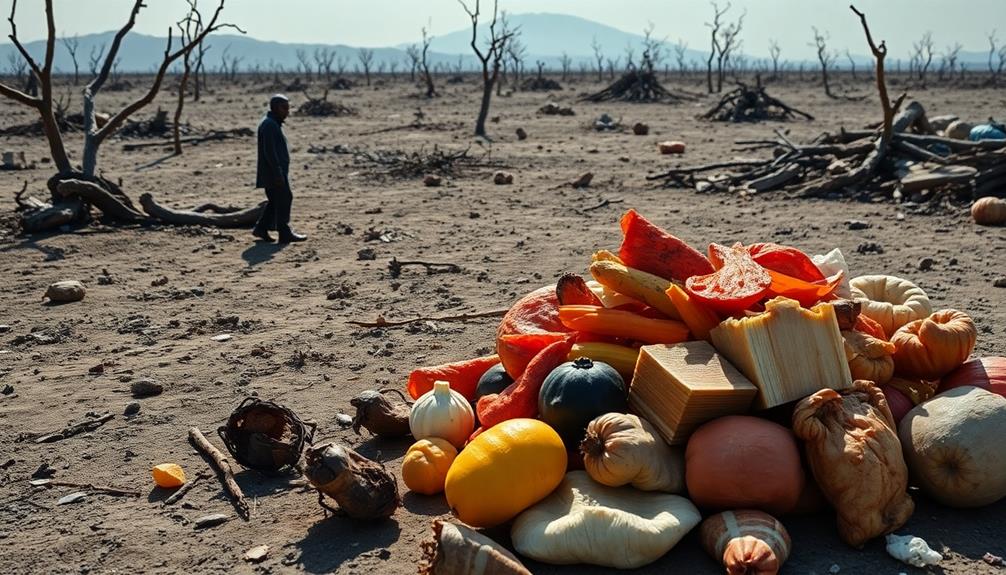
Throughout history, food aversions have often emerged in response to significant events and societal changes. You may notice that certain foods become taboo due to their historical associations with persecution or disaster. For instance, the aversion to pork in Jewish communities stems from centuries of cultural and religious significance, manifesting as a lasting food taboo even during recovery from disasters.
Similarly, certain ingredients like cassava, which is a staple in many cultures, may be viewed with suspicion in post-disaster societies due to its historical ties to famine or scarcity, especially following periods of hardship where food security was threatened a rich culinary landscape.
Additionally, misconceptions about food safety can lead to widespread avoidance. Remember the historical fear of tomatoes, once believed to be toxic? Such beliefs can linger long after the initial disaster has passed.
Cultural symbols also play a role; foods linked to tyranny may be rejected entirely during recovery efforts, reflecting a deep societal need for safety and stability.
Moreover, some foods are revered as sacred, often tied to deities or religious practices. This reverence can lead to their avoidance, as consuming them may be seen as sacrilegious.
Psychological Impacts of Disasters

After experiencing a disaster, the psychological toll can markedly shape food choices and behaviors. You might find that psychological trauma leads you to develop food taboos, as certain foods become associated with negative experiences during the crisis. For instance, the fear of foodborne illness or contamination can make you avoid specific foods perceived as unsafe, solidifying these taboos within your mind.
Additionally, traditional foods that once brought comfort may now evoke feelings of distress, as they could remind you of the trauma experienced during the disaster—this could happen with foods like Yekolo (Roasted Barley), which may have been a staple during times of scarcity. Cultural memory plays a significant role in influencing your food choices. Even if certain foods are safe to consume, you may shy away from them simply because they remind you of past traumatic events.
This heightened sensitivity to food attributes often stems from psychological distress experienced during the disaster, making it difficult for you to enjoy meals without recalling the crisis.
In post-disaster communities, shared food taboos emerge as collective memories of trauma bind individuals together. These taboos can persist long after the immediate crisis has passed, affecting how you and others in your community approach meals and gatherings.
Ultimately, the psychological impacts of disasters not only shape your food choices but also redefine your relationship with food in profound ways.
Societal Influences on Food Choices

In the wake of a disaster, societal influences can heavily shape your food choices, often intertwining with historical associations and cultural perceptions. You might find certain foods avoided due to food taboos linked to past traumas, like persecution or toxic misconceptions.
Societal trends play a significant role here, as collective memories of societal collapses can create long-lasting avoidance patterns. Economic factors also come into play; for instance, in India, cows hold immense economic value, leading to cultural reverence and specific dietary restrictions.
This intersection of economics and culture reinforces food taboos that persist over generations. Additionally, religious beliefs shape your choices, as seen in Jewish dietary laws prohibiting pork, deeply rooted in historical practices.
Social dynamics, including migration, can further propagate these taboos. As communities adapt, the fear of social repercussions and stigma associated with consuming taboo foods can deter you from incorporating them into your diet.
Consequently, you may find yourself conforming to cultural norms and dietary restrictions, influenced by a complex web of societal expectations and historical narratives.
Religious Restrictions and Dietary Laws

Food choices in post-disaster societies aren't just influenced by societal norms and historical traumas; they're also heavily shaped by religious restrictions and dietary laws.
These laws often dictate what foods are considered taboo, such as the Jewish prohibition against pork or the Islamic requirement for halal preparations. In Hindu culture, cows are sacred, leading to a strong aversion to beef consumption.
When disasters strike, maintaining these dietary laws becomes essential for communities aiming to preserve their cultural identity.
However, this adherence complicates food aid logistics, as relief efforts must navigate these restrictions. Emergency rations that include religiously prohibited foods can face community rejection, jeopardizing the effectiveness of aid.
To mitigate this, sensitive planning is imperative. Disaster response teams must prioritize understanding the religious and cultural dynamics at play.
By ensuring that food aid aligns with dietary restrictions, they promote both acceptance and respect within affected communities.
Ultimately, recognizing the significance of religious dietary laws in post-disaster settings is vital for fostering community resilience and cohesion.
Food Safety Perceptions

When you think about food safety in a post-disaster setting, cultural influences and historical contexts play a huge role in shaping your perceptions.
You might avoid certain foods not just because of recent events, but also due to lingering taboos rooted in past experiences with illness.
Understanding these factors can help clarify why some foods become off-limits, even when conditions improve.
Cultural Influences on Safety
Cultural influences shape how communities perceive food safety, often leading to the establishment of taboos surrounding certain items. These perceptions are deeply rooted in cultural associations and historical experiences, which can create significant barriers to dietary choices.
You might notice that:
- Certain foods, like tomato leaves, are avoided due to knowledge of their toxic parts, overshadowing their nutritional benefits.
- Complex food preparation processes can lead to misunderstandings about safety, making some dishes less popular despite their potential value.
- Economic disinformation campaigns may paint specific foods as dangerous, perpetuating fears and influencing public perception.
These factors contribute to food taboos, as societal beliefs about health risks can drive people to avoid items believed to attract disease-carrying pests.
Historical persecution or negative experiences compound these fears, reinforcing the stigma surrounding certain foods.
Ultimately, understanding these cultural influences on food safety perceptions helps you navigate the complexities of dietary choices in post-disaster societies.
Recognizing the interplay of cultural beliefs and misconceptions allows for a more informed approach to food, encouraging healthier and more inclusive eating practices.
Historical Context of Taboos
Perceptions of food safety throughout history have shaped the way communities establish taboos around certain items. These taboos often arise from cultural associations linked to historical events, such as the avoidance of pork and shellfish due to religious bans.
Past misconceptions, like the belief that tomatoes were toxic, illustrate how misinformation can lead to societal rejection of specific foods. Over generations, dietary practices have evolved, influenced by the perceived undesirable characteristics of certain items, such as unpleasant odors or appearances.
Economic disinformation campaigns can also play a role in establishing food taboos. When certain foods are negatively portrayed, it can threaten competing food industries, leading to broader societal rejection.
Additionally, collective memory of past disasters or health crises perpetuates these taboos, as communities often steer clear of foods they associate with adverse effects.
In essence, these historical contexts shape what you deem safe or taboo in your diet, reflecting deep-rooted beliefs and collective experiences. Understanding this background helps you navigate the complexities of food safety perceptions in your own community.
Economic Factors Affecting Food Acceptance

When you're maneuvering food choices in a post-disaster environment, the cost of emergency foods can heavily influence what you accept or reject.
Economic stigma may lead you to view certain options as inferior or undesirable, shaping your perceptions around what's acceptable to eat.
Understanding these factors helps clarify why some foods become taboo, even when they might be necessary for survival.
Cost of Emergency Foods
While economic constraints often dictate the availability and quality of emergency foods, these factors play an essential role in shaping what communities accept during crises. The cost of emergency foods often forces governments to rely on lower-cost options that may not meet nutritional needs, creating several challenges:
- Quality Compromises: Budget limitations lead to procurement strategies that favor quantity over quality, leaving communities with subpar food options.
- Increased Food Waste: Unused emergency supplies contribute to economic losses, emphasizing the need for strategic planning to minimize waste and improve resource allocation.
- Health Disparities: Lower-income populations suffer most, as inadequate food provisions can exacerbate health disparities during disaster recovery.
Advanced preservation methods might seem costly upfront, but they can save money long-term by reducing waste and ensuring food safety during distribution.
Integrating emergency food provisions into social welfare programs can also address nutritional support for vulnerable groups, bridging gaps created by economic constraints.
Ultimately, understanding the cost of emergency foods is essential for developing effective procurement strategies that prioritize both quality and accessibility, ensuring that communities can recover and thrive in the aftermath of a disaster.
Economic Stigma and Taboos
Economic stigma and taboos surrounding food often arise from cultural beliefs and historical contexts that influence what communities accept or reject. For instance, in India, the economic significance of cows creates consumption restrictions, leading to a stigma around eating beef. This cultural significance fosters negative perceptions of alternative protein sources, making them taboo.
Economic dependency on specific foods, such as rice or maize, can also shape public consumption patterns. If a community relies heavily on one food source, alternatives may be seen as inferior or undesirable. Governments may exploit this by imposing restrictions on certain foods to maintain control over the food supply, further entrenching economic stigma.
Moreover, the high costs associated with certain foods can limit access for lower-income populations, branding these items as elitist. This perception dissuades individuals from embracing such foods.
Additionally, historical disinformation campaigns often demonize specific food items, steering public consumption towards more profitable options while reinforcing taboos against those foods.
Nutritional Implications of Taboos

Taboos surrounding certain foods in post-disaster societies can greatly impact nutritional health. When individuals reject specific foods based on cultural beliefs, they often limit their dietary diversity, leading to nutritional deficiencies. This is especially concerning for vulnerable populations, such as children and the elderly, who may already be at risk of malnutrition.
Consider these implications:
- Limited Nutrient Intake: Avoiding key food sources can prevent access to essential vitamins and minerals, exacerbating health recovery challenges.
- Gastrointestinal Issues: Relying on high salt and sugar content in available emergency food can lead to gastrointestinal disorders, complicating recovery further.
- Food Security Challenges: Dietary restrictions due to taboos can hinder overall food security, making it harder for communities to recover from disaster impacts.
Without accepting fortified and unfamiliar foods during emergencies, communities may struggle to meet their micronutrient needs, perpetuating malnutrition.
Ultimately, addressing these taboos is vital for ensuring a healthier post-disaster environment where everyone has access to a diverse and nutritious diet.
Addressing Food Taboos in Aid

In post-disaster scenarios, understanding and addressing food taboos is vital for effective aid delivery. Cultural taboos can greatly influence the acceptance of food aid, as certain items may be avoided due to historical associations or religious beliefs.
To guarantee that your emergency response resonates with affected communities, you need to take into account local dietary restrictions. Incorporating culturally acceptable foods into your food packages enhances community trust and cooperation, making your aid efforts more effective.
Conducting surveys and consultations with local populations helps identify specific food taboos, allowing you to tailor your aid to align with community norms and preferences. This approach not only addresses nutritional needs but also fosters a sense of respect and understanding.
Failing to acknowledge food taboos can lead to wasted resources, as individuals may refuse aid that doesn't fit their dietary practices. By prioritizing the cultural context of the communities you're assisting, you'll improve the chances of your food aid being accepted and utilized effectively.
Ultimately, addressing food taboos in aid not only fulfills nutritional needs but also strengthens the bond between aid providers and communities in need.
Strategies for Inclusive Food Distribution
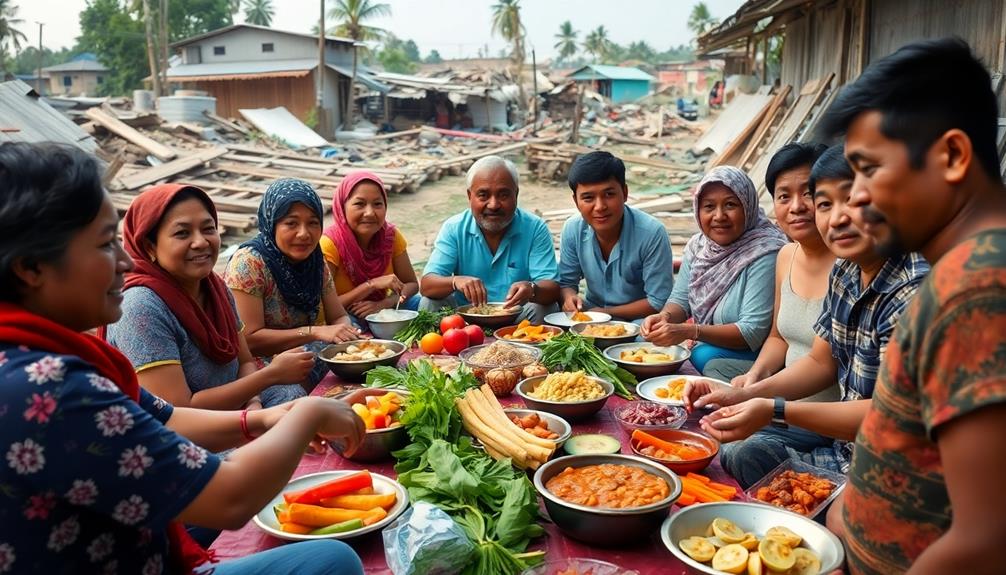
Understanding local dietary restrictions sets the stage for effective food distribution strategies in post-disaster contexts. By recognizing cultural preferences and nutritional concerns, you can guarantee community acceptance while minimizing food wastage.
Here are three key strategies to take into account:
- Collaborate with local organizations: Partner with nutritionists and community leaders to develop culturally appropriate meal options that cater to diverse dietary restrictions, such as religious or health-related needs.
- Utilize shelf-stable foods: Focus on easily distributed items like canned goods and fortified beverages. These are essential during emergencies when access to fresh produce is limited, allowing for a timely disaster response.
- Implement feedback mechanisms: Actively engage with affected populations to gather insights on their food preferences. This allows you to refine future food distribution strategies, guaranteeing alignment with community tastes.
Frequently Asked Questions
What Are the Roles of Food Taboos in Society?
Food taboos play significant roles in society, shaping cultural identity and reinforcing social norms. They guide behavior, create cohesion, and reflect values. Understanding these taboos helps you navigate complex social landscapes and appreciate diverse perspectives.
Why Is Food Important in a Natural Disaster?
In a natural disaster, you can't just munch on chips while the world crumbles. Food's essential for survival; it fuels bodies, restores strength, and keeps spirits high in chaos. Nutritional balance is your best friend.
What Food Is Good for Natural Disasters?
For natural disasters, you should stockpile shelf-stable foods like canned goods, dried fruits, grains, and legumes. These options provide essential nutrients, energy, and longer storage life, ensuring you stay nourished during emergencies.
Why Are Foods Important in Survival Kits?
Foods in survival kits are essential for providing necessary nutrients and calories. They help prevent malnutrition and guarantee you stay energized during emergencies, making it important to select shelf-stable, culturally acceptable options that support recovery.
Conclusion
In post-disaster societies, food taboos can shape recovery efforts, affecting what people will or won't accept. For instance, studies show that nearly 60% of disaster-affected populations refuse certain foods due to cultural beliefs. Understanding these taboos is essential for aid organizations to foster trust and guarantee successful food distribution. By respecting dietary preferences and addressing psychological impacts, we can help communities rebuild not just physically, but also culturally, paving the way for healing and resilience.
-

 Vetted5 months ago
Vetted5 months ago14 Best Personalized Father's Day Gifts for Your Husband – Show Him You Care
-

 Alfresco5 months ago
Alfresco5 months agoAlfresco Stacker Doors: Seamless Indoor-Outdoor Living!
-

 Vetted6 months ago
Vetted6 months ago15 Best EMS Foot Massagers for Neuropathy to Soothe Your Feet
-

 Craft and Textiles7 months ago
Craft and Textiles7 months ago15 Best Places to Buy Appliances for Your Home – Top Retailers Reviewed
-

 Vetted5 months ago
Vetted5 months agoBattle Born Batteries Review: Reliable Power Solution
-

 Vetted5 months ago
Vetted5 months agoD-Link Switch Review: Lite Layer 3 Managed Networking
-

 Tableware and Dining Accessories7 months ago
Tableware and Dining Accessories7 months agoWhat Is the Meaning of the Word Tableware
-

 Tableware and Dining Accessories7 months ago
Tableware and Dining Accessories7 months agoWhat Is the Hindi Meaning of Tableware




























